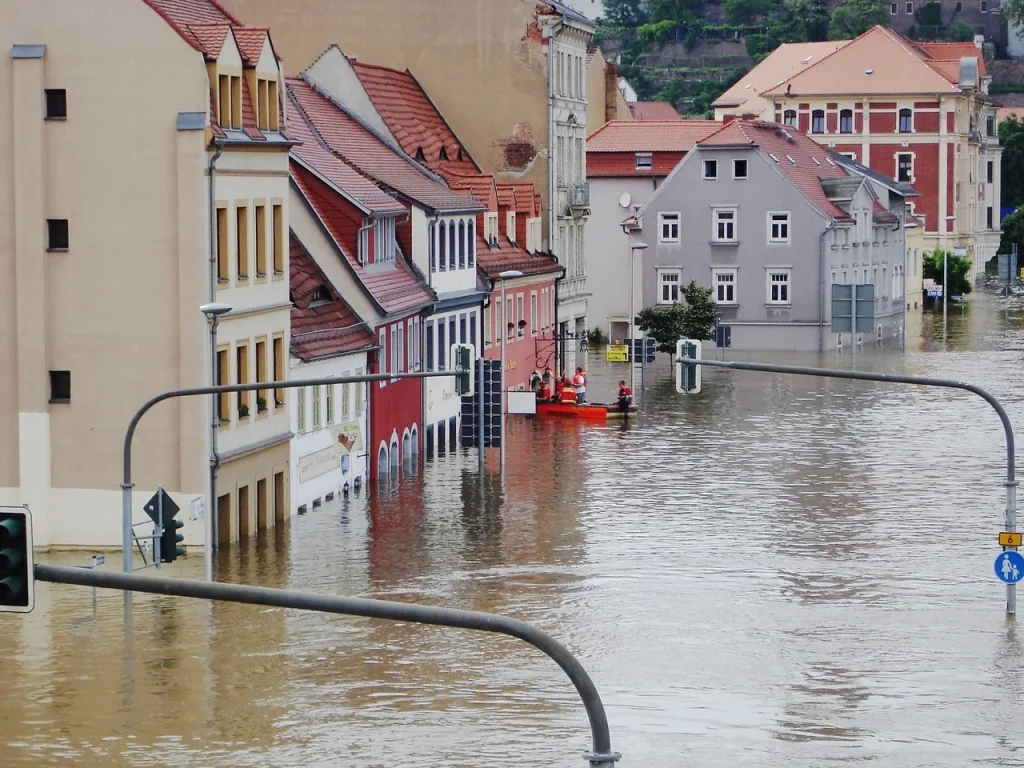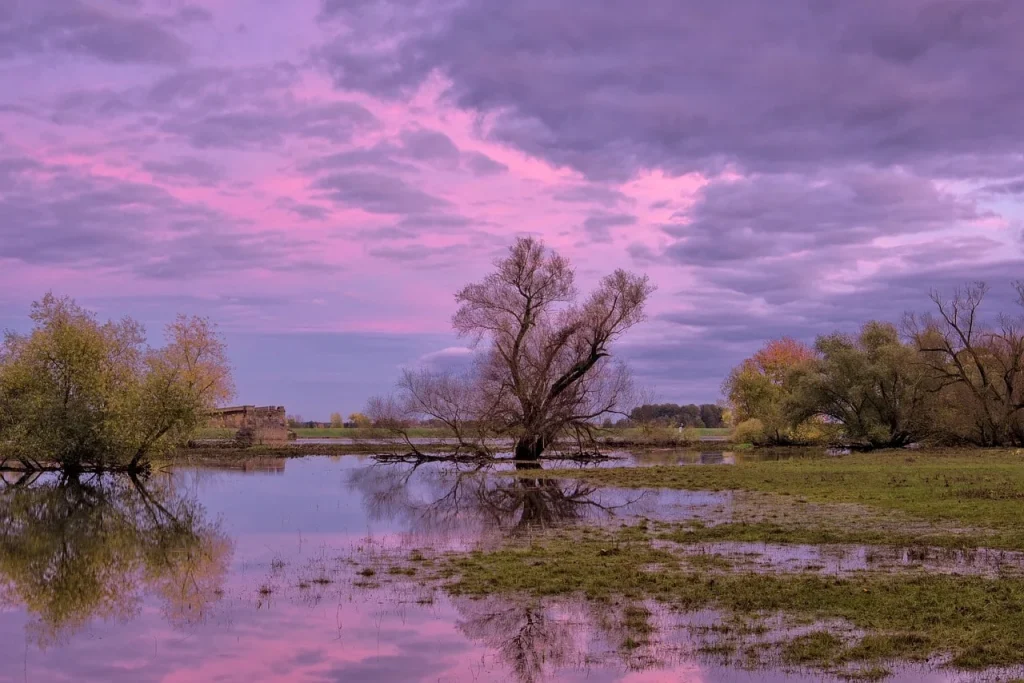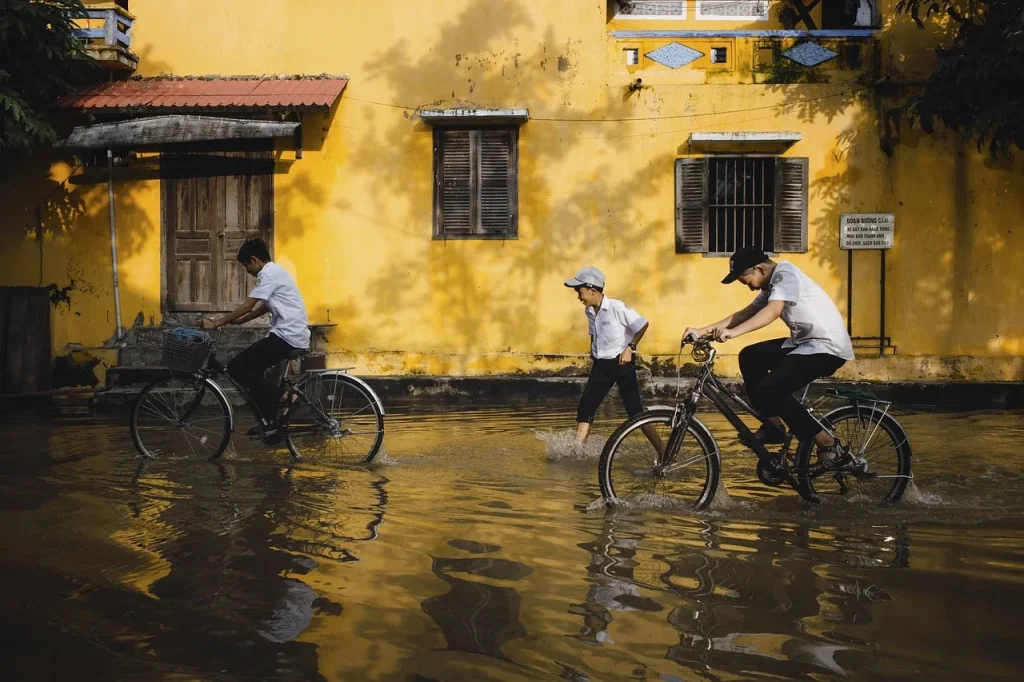Every year, floods affect more people worldwide than any other natural disaster. They can come on quickly, leaving a trail of destruction, but they also play a crucial role in nurturing our ecosystems. But what exactly are floods, and why do they happen?
I will take you through some interesting facts about floods, from their origins to their effects on human civilization and the environment. We’ll explore how floods have been both a curse and a boon throughout history, offering insights into the power of water in shaping our world.
Floods are ‘acts of God,’ but flood losses are largely acts of man.
Gilbert F. White
Floods Facts
As you embark on the journey through the complex and often devastating world of floods, remember that each detail holds the key to understanding their full impact. Make sure to absorb every fact, as a quiz at the article’s end will challenge you to prove your expertise on this critical subject.
- The deadliest flood in history occurred in 1931 in China, claiming millions of lives.
- Flash floods can occur within minutes following heavy rainfall or a dam break.
- Underwater glacial lakes can unleash catastrophic events when their dams, made of ice, fail.
- Urban areas are especially vulnerable due to impermeable surfaces like roads and sidewalks.
- The phenomenon of a river overflowing its banks is not the only cause; heavy rain, dam breaks, and snowmelt also contribute.
- Mangrove forests act as natural barriers against sea-level rise and storm surges.
- Climate change is increasing the frequency and severity of these disasters.
- More people are affected by this disaster type globally than by any other natural disaster.
- Ancient flood myths, like Noah’s Ark, exist in many cultures worldwide, suggesting a historical prevalence of large-scale events.
- The term “100-year event” does not imply it happens once every century, but rather there’s a 1% chance of occurring each year.
- Soil saturation levels before a storm greatly influence the likelihood and impact of flooding.
- Venice, Italy, is famous for its acqua alta, or high water, phenomenon, a combination of tides and storm surges.
- Insurance claims for these events often exceed billions of dollars annually in the U.S. alone.

- Beavers can naturally mitigate flooding by building dams that slow down water flow.
- The creation of wetlands is a sustainable approach to managing and mitigating these disasters.
- Subterranean floods in metro systems can cause extensive economic and infrastructural damage.
- A significant portion of the Netherlands is below sea level, making it vulnerable to sea flooding.
- Smart flood barriers are being developed that automatically deploy when water levels rise.
- In ancient times, floods were often seen as acts of gods meant to cleanse or punish.
- Cloud seeding has been experimented with to prevent heavy rainfalls that could lead to major incidents.
- Flash events are the most dangerous type, with water levels rising rapidly in a short period of time.
- The Mississippi River’s Great Flood of 1927 led to significant social and political changes in the U.S.
- Some fish species thrive in floodplain environments, benefiting from the increased habitat area and nutrients.
- Agricultural flood management practices include creating buffer zones and restoring meander patterns in rivers.
- Mosquito populations can surge after a flood, leading to outbreaks of diseases like malaria and the West Nile virus.
- Groundwater flooding, less known but impactful, occurs when water levels rise to the surface from saturated soils.
- Ancient civilizations like the Mesopotamians relied on predictable flooding patterns to enrich agricultural lands.
- The concept of living with water has led to innovative architectural designs like floating homes and amphibious buildings.

- Landslides can be triggered by the saturation of steep terrain during heavy rains, compounding the disaster’s impact.
- The Great Flood of 1993 on the Mississippi and Missouri rivers was one of the most costly and destructive in U.S. history.
- Remote sensing technology now allows for the rapid assessment of affected areas, improving response times.
- Reforestation efforts can reduce the risk by increasing the amount of water the soil can absorb.
- Ice jam floods occur when chunks of ice block the flow of a river, causing water to spill over the banks.
- Post-disaster, the risk of waterborne diseases like cholera and hepatitis A increases due to contaminated water sources.
- Artificial intelligence is being used to predict and model disaster risks, potentially saving lives and resources.
- Sandbagging is a traditional but labor-intensive method to create barriers against rising water levels.
- In 2010, Pakistan faced one of the largest disasters of this kind in its history, affecting over 20 million people.
- The construction of levees and dams, while protective, can also cause water to be diverted to other areas, increasing risk elsewhere.

- Displaced soil and sediment can lead to long-term environmental consequences, affecting agriculture and water quality.
- The loss of wetlands globally increases the vulnerability of coastal areas to storm surge and sea-level rise.
- Traditional flood myths often symbolize the destruction and renewal of the earth, reflecting the natural cycle of life.
- Vehicle engines can be irreparably damaged if water enters, making car recovery after a major incident often impractical.
- Historical records of floods are used in modern times to understand and predict flood patterns.
- Green roofs on urban buildings can absorb rainwater, reducing runoff and mitigating urban flood risks.
- The introduction of flood-resistant crops is helping communities in flood-prone areas maintain their livelihoods.
- Early warning systems have become crucial in reducing human casualties during sudden events.
- Insurance gaps mean that many affected by these disasters are not financially protected against losses.
- The longest river in the world, the Nile, has a history of nourishing civilizations through its annual inundations.
- Stagnant water after a flood can lead to the formation of mold in homes, posing long-term health risks.
- Submerged archaeological sites often provide unique insights into past human settlements, revealing how ancient communities adapted to water-based challenges.
Floods Myths

We continue our journey. It’s time to separate what’s true from what’s simply a myth. Let’s find out.
- Floods Only Happen in Coastal Areas
They are not confined to coastal areas alone; they can occur anywhere, including inland regions. Heavy rains, melting snow, or dam failures can cause rivers, lakes, and streams to overflow, leading to flooding in unexpected places. - Flash Floods Require Hours to Develop
Contrary to popular belief, flash floods can develop within minutes following a heavy rain event or dam breach. The rapid onset of flash floods provides little time for warning, underscoring the importance of staying alert to weather advisories. - If You Haven’t Flooded Before, You Won’t Flood Now
The history of flooding in an area does not guarantee future immunity. Changes in land development, climate conditions, and the natural aging of flood defenses can make previously unaffected areas susceptible to flooding. - Flood Insurance is Only for High-Risk Areas
Regardless of the perceived risk level, flood insurance can be a wise investment. Flooding can affect properties in moderate-to-low risk areas, and standard homeowners insurance policies often do not cover flood damage. - Moving to Higher Ground During a Flood is Unnecessary if You’re Inside
During a flood, seeking higher ground is crucial, even if you’re indoors. Water levels can rise quickly, endangering those in lower floors. It’s essential to evacuate to a safe location if advised by authorities.
Floods Quotes

Let’s continue with some quotes about floods. You can always share some in the comments, and I will add them to the list.
A flood is not just water; it’s a reshaping of the landscape.
John M. Barry
John M. Barry, known for his works on the impact of the Great Mississippi Flood, highlights how floods can permanently transform the physical and social landscapes.
When the well’s dry, we know the worth of water.
Benjamin Franklin
Benjamin Franklin, one of the Founding Fathers of the United States, reflects on the value of water resources and implies their critical role, especially noticeable during floods and droughts.
To a man whose only tool is a hammer, every problem looks like a nail; to a man who only knows floods, every problem is solved by flowing.
Anonymous
This anonymous quote metaphorically suggests that one’s perspective or solutions are limited by their experiences or knowledge, especially in the context of managing or understanding floods.
The flood of time is a bitter draught.
William Shakespeare
William Shakespeare, the eminent English playwright and poet, uses the concept of a flood as a metaphor for the relentless and often harsh passage of time.
In the world of water, we are all downstream and upstream from someone.
Sandra Postel
Sandra Postel, a global expert on freshwater issues and sustainability, articulates the interconnectedness of water systems and the collective responsibility in managing flood risks and water resources.
Floods FAQ

As we approach the FAQ section, remember that this is your last stop before the quiz. Pay close attention to these frequently asked questions to ensure you’re fully prepared.
- Can Floods Cause Earthquakes?
While it might seem like a stretch, in some cases, it can indirectly lead to seismic activity. Large, rapid changes in water weight on the Earth’s surface due to flooding can potentially trigger what are known as “induced seismic events” or minor earthquakes. However, these are relatively rare and usually not as powerful as natural earthquakes. - Are Floods Natural Disasters?
Yes, they are considered natural disasters. They occur when water inundates land that is normally dry, which can happen due to various reasons, including heavy rainfall, storm surges, or the melting of snow and ice. While natural processes largely drive floods, human activities like deforestation and urban development can exacerbate their severity. - How Does Flood Insurance Work?
Flood insurance is a specific policy separate from standard homeowners’ insurance that covers property damage due to flooding. To obtain it, your community needs to participate in the National Flood Insurance Program (NFIP), or you can purchase it from private insurers. It typically covers the building’s structure and contents, but there are limitations, so it’s essential to understand the details of your policy. - How Do Floods Affect Animals and Wildlife?
They can have mixed effects on wildlife. While some aquatic species might benefit from the increased water levels, most terrestrial animals suffer from habitat loss, decreased food availability, and increased vulnerability to predators. Efforts to evacuate or provide for wildlife during floods are crucial to mitigating these impacts. - Can Technology Predict Floods?
Yes, technology plays a vital role in predicting them. Advanced meteorological models, satellite imagery, river gauge data, and hydrological forecasting tools are used to monitor weather patterns, predict rainfall, and assess flood risks. These tools enable earlier warnings and more prepared responses to potential flooding.
Floods Trivia

Welcome to our flood trivia quiz! Remember, if you don’t get at least one question right, you might find your knowledge of floods as shallow as a puddle on a sunny day.
Conclusion
In summary, floods are a natural phenomenon that can cause significant changes to our environment and lives. This article has shed light on various aspects of floods, highlighting their causes, effects, and measures we can take to mitigate their impact.
Staying educated and prepared is key to navigating these challenges successfully. Let’s keep the dialogue going and support efforts to manage flood risks in our communities. Together, we can weather any storm. Till next time, stay curious and explore more. Cheers.


